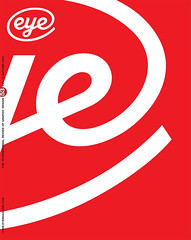Autumn 2004
Written all over the body
An ‘encyclopaedia’ of Russian prison tattoos exposes a complex graphic subculture. Critique by Rick Poynor
Tattoos have become fashion accessories in recent years and there is no shortage of books about them. As a rule these are not much more than cheaply produced picture collections bulging with colour pin-ups of men and women proudly displaying their body ornaments. Russian Criminal Tattoo Encyclopaedia, published by Steidl in association with the design team Fuel, takes a totally different approach. Instead of large, obvious, paperback pages it offers something much more concentrated and strange.
The book is a 400-page hardback not much bigger or heavier than a prayerbook, with a traditional cloth binding and a thick, salmon-pink dustjacket. The title typeface, Berliner Grotesk, centred above a skull puffing on a fat cigar, makes the volume look like something published decades ago that has come to light in a dusty corner of a second-hand bookshop. The Encyclopaedia contains black and white photographs of Russian convicts by Sergei Vasiliev (the avoidance of colour signals its ambitions as a document), an essay by lexicographer and folklorist Alexei Plutser-Sarno, and a series of drawings of tattoos by Danzig Baldaev, who also contributes a foreword.
The style of the drawings, copied from criminals’ bodies in jail, corrective labour colonies, isolation cells, swimming pools, bathhouses and sometimes the morgue, is a cross between Mexican printmaker J. G. Posada and underground cartoonist Robert Crumb and the imagery is equally bizarre and often obscene. Baldaev, now in his 70s, has been collecting the tattoos since the 1940s when his father, a scholar accused by the state of being ‘an enemy of the people’, urged him to make a record of these anti-social markings so they wouldn’t be lost. The use of drawing imposes a graphically consistent style of presentation on the images and allows their iconography to be studied with greater attention. The book provides translations of the texts that feature in most tattoos, as well as information about a tattoo’s meaning and sometimes additional details about the person it came from.
As the book convincingly reveals, this is a realm of unexpected graphic complexity. The tattoos are not mere decorations and there is nothing arbitrary about any of their elements. They are a form of speech, and every symbol has a meaning that can be understood. A thief’s entire biography can be written on the body in this way and, as Plutser-Sarno explains, the tattoos provide his bureaucratic documents, a complete ‘service record’ of achievements and failures, promotions and demotions, time spent in jail and ‘transfers’ to different types of ‘work’. In the society of thieves, a man without tattoos has no social status. Tattoos are used to set out the rules and rituals of this hidden society, to regulate behaviour and maintain order. Any thief who tries to elevate his own position by misappropriating the tattoos of a ‘legitimate thief’ is likely to be killed, and other kinds of false tattoo are forcibly excised from the body. Tattoos can also be imposed as a punishment, as a way of marking and degrading the wearer.
Many of the tattoos indicating a thief’s background and position are worn like rings on the fingers. A crown in two rectangles denotes a criminal boss or ‘authority’. An eight-pointed star in a circle means ‘I became a thief because of poverty and a broken home’. Six dots indicate a convict at the lowest level of convict society, who acts as a servant to the criminal bosses. A rabbit means ‘a lover of women’ or ‘a lover of group sex’. A heart in a rectangle indicates a despised convict with no status, such as a rapist.
Why are these images so fascinating to us? Plutser-Sarno argues that it’s because the world of thieves long ago became the model for society as a whole. ‘Our popular entertainers sing songs in criminal jargon, authors write entire novels in it, thousands of films are made about the criminal world, in which noble bandits "bump off" ignoble ones by the dozen or vice-versa.’ Criminal culture has infiltrated life far more completely than we grasp. This has special political resonance in Russia, but it is also true elsewhere. Although it has been assembled with care – you can’t quite call it good taste – this book, too, is bound to be consumed as a fashion accessory, as its text freely admits. Still, it succeeds in presenting an often alarming glimpse of ‘filth from our slavish past’ – as Baldaev puts it – and stands as an indictment of the state that created the brutal penal conditions in which this violent underworld found its soil.
Rick Poynor, writer, founder of Eye, London
First published in Eye no. 53 vol. 14 2004
Eye is the world’s most beautiful and collectable graphic design journal, published quarterly for professional designers, students and anyone interested in critical, informed writing about graphic design and visual culture. It is available from all good design bookshops and online at the Eye shop, where you can buy subscriptions and single issues.

